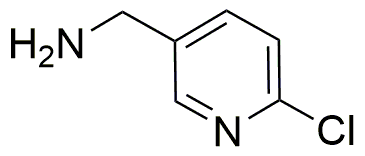5-(Aminomethyl)-2-chloropyridine is widely utilized in research focused on:
- Pharmaceutical Development: This compound serves as a key intermediate in the synthesis of various pharmaceuticals, particularly those targeting neurological disorders, enhancing drug efficacy.
- Agricultural Chemicals: It is used in the formulation of agrochemicals, providing effective solutions for pest control while minimizing environmental impact.
- Material Science: The compound is employed in creating advanced materials, such as polymers and coatings, that offer improved durability and resistance to chemicals.
- Biochemical Research: Researchers utilize it as a building block in the development of novel biochemicals, aiding in the study of biological pathways and mechanisms.
- Analytical Chemistry: It acts as a reagent in various analytical techniques, helping to improve the sensitivity and specificity of detection methods in complex mixtures.
General Information
Properties
Safety and Regulations
Applications
5-(Aminomethyl)-2-chloropyridine is widely utilized in research focused on:
- Pharmaceutical Development: This compound serves as a key intermediate in the synthesis of various pharmaceuticals, particularly those targeting neurological disorders, enhancing drug efficacy.
- Agricultural Chemicals: It is used in the formulation of agrochemicals, providing effective solutions for pest control while minimizing environmental impact.
- Material Science: The compound is employed in creating advanced materials, such as polymers and coatings, that offer improved durability and resistance to chemicals.
- Biochemical Research: Researchers utilize it as a building block in the development of novel biochemicals, aiding in the study of biological pathways and mechanisms.
- Analytical Chemistry: It acts as a reagent in various analytical techniques, helping to improve the sensitivity and specificity of detection methods in complex mixtures.
Documents
Safety Data Sheets (SDS)
The SDS provides comprehensive safety information on handling, storage, and disposal of the product.
Product Specification (PS)
The PS provides a comprehensive breakdown of the product’s properties, including chemical composition, physical state, purity, and storage requirements. It also details acceptable quality ranges and the product's intended applications.
Certificates of Analysis (COA)
Search for Certificates of Analysis (COA) by entering the products Lot Number. Lot and Batch Numbers can be found on a product’s label following the words ‘Lot’ or ‘Batch’.
*Catalog Number
*Lot Number
Certificates Of Origin (COO)
This COO confirms the country where the product was manufactured, and also details the materials and components used in it and whether it is derived from natural, synthetic, or other specific sources. This certificate may be required for customs, trade, and regulatory compliance.
*Catalog Number
*Lot Number
Safety Data Sheets (SDS)
The SDS provides comprehensive safety information on handling, storage, and disposal of the product.
DownloadProduct Specification (PS)
The PS provides a comprehensive breakdown of the product’s properties, including chemical composition, physical state, purity, and storage requirements. It also details acceptable quality ranges and the product's intended applications.
DownloadCertificates of Analysis (COA)
Search for Certificates of Analysis (COA) by entering the products Lot Number. Lot and Batch Numbers can be found on a product’s label following the words ‘Lot’ or ‘Batch’.
*Catalog Number
*Lot Number
Certificates Of Origin (COO)
This COO confirms the country where the product was manufactured, and also details the materials and components used in it and whether it is derived from natural, synthetic, or other specific sources. This certificate may be required for customs, trade, and regulatory compliance.

